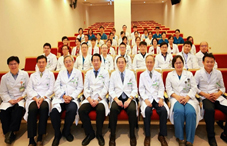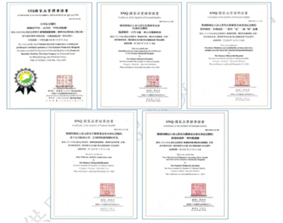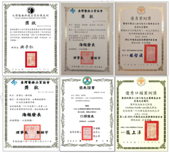
The Department of Chest Medicine at Far Eastern Memorial Hospital has
established a patient-centered, interdisciplinary respiratory care model.
Guided by the core values of precision medicine, team collaboration,
sustainable carbon reduction, process optimization, quality improvement,
innovative development, and pursuit of excellence, the department has developed
and implemented an integrated care system involving physicians, nurses,
pharmacists, and dietitians. This model is deeply embedded in disease-specific
medical strategies and continues to shape a high-quality Center of Excellence for
pulmonary care.
Under the philosophy and culture of Total Quality Management (TQM), all
medical services, care delivery, and strategic execution are centered on the
patient. The department emphasizes innovation, continuous improvement, analysis
and review, standardization, and implementation to establish a robust quality
culture in pulmonary medicine. Strategies and work plans are formulated based
on clinical needs, team missions, and annual objectives, driving various
initiatives. In alignment with hospital-wide quality frameworks, the department
has assigned dedicated personnel for patient safety, quality improvement
(indicator liaisons), and ISO compliance. Regular monthly departmental meetings
are held to report on quality-related matters.
Monthly team meetings are conducted to analyze and review performance
indicators. For abnormal indicators, improvement plans are proposed and tracked
using the PDCA (Plan-Do-Check-Act) cycle. Below are key aspects and tangible
results of our TQM culture:
1. Culture of Innovation and R&D
The department fosters innovation as a central pillar of medical care. It
focuses on new ideas, technologies, developments, and services to build novel
healthcare models. Examples include:
Precision medicine using exhaled nitric oxide for asthma management
Development of a 5G AI-based voiceprint monitoring system for asthma care
Big data-driven predictive modeling for extubation outcomes and ARDS risk
assessment in respiratory therapy
2. System Optimization and Innovation
The majority of patients in the department are inpatients. For high-risk
patients, real-time system alerts enable the care team to take timely actions,
reducing intubation and emergency incidents. Additional innovations include:
Alert systems for COPD patients overusing oral steroids
SABA (short-acting beta-agonist) overuse warnings in asthma patients
Optimized electronic respiratory therapy systems
These digital innovations enhance care quality through improved system
integration.
3. Culture of Continuous Quality Improvement
All clinical quality indicators are regularly monitored, analyzed, and
reviewed. Immediate adjustments are made as needed, and PDCA cycles are
implemented to strategize and execute improvements. Examples include:
Reducing average length of stay for pulmonary inpatients
Increasing smoking cessation success rates in COPD patients
Expanding telemedicine services and remote health consultations
4. Standardized Process Implementation
Medical procedures are documented into standardized operating procedures
to ensure consistent and accurate care. For instance:
RCC (Respiratory Care Center) developed standardized weaning protocols,
leading to one of the highest weaning success rates nationwide
Standardized protocols for pulmonary rehabilitation, with top execution
rates across the country
5. Indicator-Based Quality Monitoring
Quality indicators are set based on clinical needs. Indicator definitions
are clearly outlined, with data collected via automated systems. Tableau
dashboards assist teams with clinical analysis, review, and improvement. Since
2018, indicator audits have ensured that designated staff understand data
definitions and address abnormalities effectively.
Tangible Achievements
The department’s commitment to team-based care, innovation, and continuous
quality improvement has led to the following achievements:
Joint Commission of Taiwan Disease-Specific Care Certification: Certified
for both "COPD Care Quality" and "Asthma Care Quality"
SNQ National Quality Mark: Awarded five SNQ National Quality
Certifications
Asthma Care: Patented (Certificate No. M670227, Taiwan Intellectual
Property Office) use of exhaled nitric oxide and 5G voiceprint technology,
achieving 94% asthma control rate; reduced oral steroid usage from 11.07% in 2019
to 2.89% in 2024; implemented ESG initiatives to reduce high-carbon medications
and devices, cutting usage by 44.83% and carbon emissions by 3,250 kgCO?e over three
years
COPD Care: With optimized team-based care, achieved a 94.29% six-month
smoking cessation success rate in 2024, highest nationwide; awarded top
national quality incentive funding from the Health Promotion Administration for
six consecutive years
Respiratory Therapy: Innovative use of Electrical Impedance Tomography
(EIT) has enhanced critical care quality, with a 74% weaning success rate at
the Respiratory Care Center
Looking Forward
To
meet future trends in smart and technological healthcare, the Department of
Chest Medicine remains committed to delivering high-quality respiratory care
through integrated team collaboration. Emphasizing precision medicine,
team-based care, system management, process optimization, innovation, and
quality enhancement, we aim to continuously improve care for respiratory
patients. We also integrate ESG principles into clinical practice to fulfill
our social responsibility in healthcare. With relentless pursuit of innovation,
strategic quality monitoring, and process improvement, we strive for
excellence—continually raising the standard of respiratory care without pause.

SNQ National Quality Mark: Awarded five SNQ National Quality Certifications

The quality of thoracic medicine has been published in various medical associations, with outstanding results.